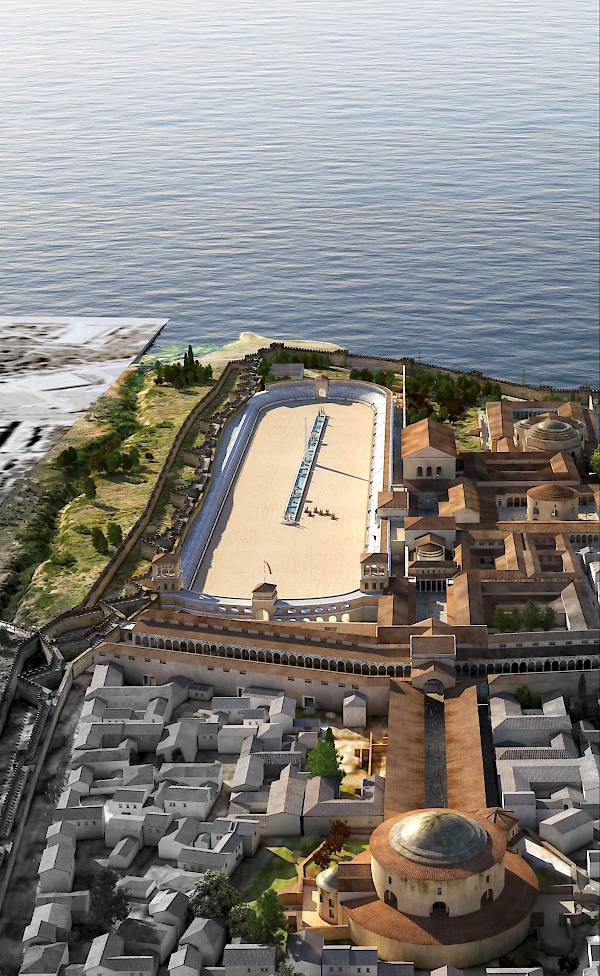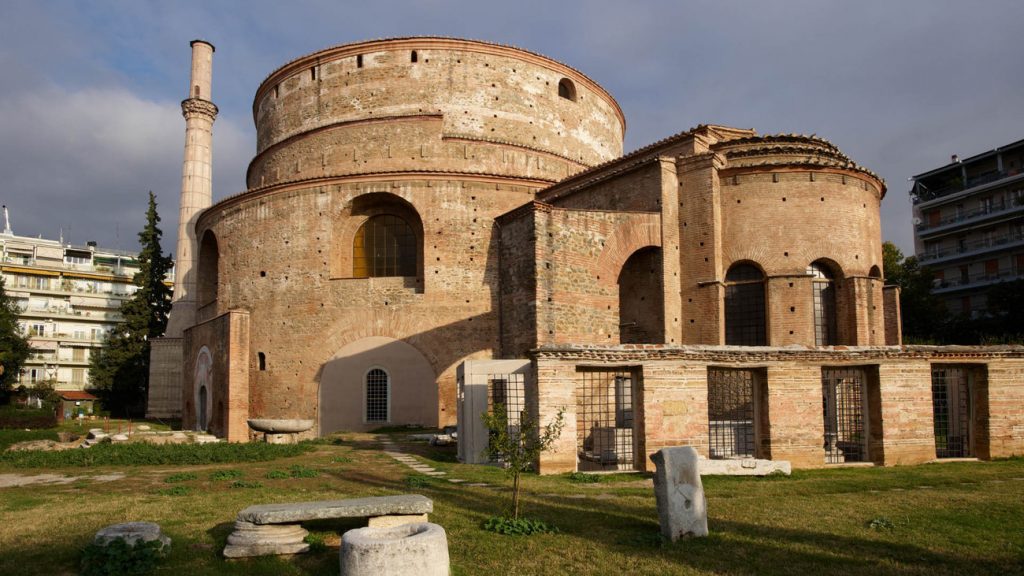
The Rotunda, built by Roman emperor Galerius in 306 AD, is the oldest of Thessaloniki’s churches and a UNESCO World Heritage Site.
It was built at the turning point between the pagan and Christian world, probably as a temple for ancient cult worship or as a mausoleum for Constantine the Great (306-337).
Rotunda, situated 125 meters northeast of the Arch of Galerius on the upper side of busy Egnatia Street, owes its name to its circular shape.
It is part of the Galerian Complex among the most well-preserved monuments of its era in Europe and includes a linear axis that connects the Rotunda with the Arch and with the sea.

The building, with a diameter of 24.5 meters, covers an isosceles dome made of bricks, reaching a height of 29.8 meters. The 6.3 meter cylindrical wall is split internally into eight rectangular niches of which the south was the main entrance.
Rotunda in Thessaloniki was converted into a church
After Galerius’s death in 311, the Rotunda stood empty for several decades until the Emperor Theodosius I ordered its conversion into a Christian church in the late fourth century.
The building was used as a church (Church of Asomaton or Archangelon) for over 1,200 years until the city fell to the Ottomans.
In 1590, it was converted into a mosque, called the Mosque of Suleyman Hortaji Effendi, and a minaret was added to the structure. It was used as a mosque until 1912, when the Greeks liberated the city during the Balkan War.
Greek Orthodox officials converted it into a church in honor of Saint George, probably because of the little church with the same name situated in its vicinity.
However, the name Rotunda was the one that prevailed due to the shape of its hemispherical dome. In 1998, it was enlisted as a World Heritage Site by UNESCO.

The brightest remnants of the Early Christian phase of the monument are the excellent mosaics.
The windows and the vestibules of the vaults at the base of the dome are decorated with mosaics whose wealth of themes with plant and geometric motifs and the splendor of colors impress the visitor.

In the dome, the large compositions were created within three successive zones. The lower one, known in the bibliography as a martyrs zone, is divided into eighths, depicting martyrs in front of monumental architectures.
In the eastern partition that was destroyed when the dome section collapsed, the damaged sections of the mosaic were completed with a wall painting by the Italian painter S. Rossi in 1889.
The middle zone of the mosaics of the dome is almost destroyed. Only the lower part is preserved, where legs of the male figures in movement, probably angels, can be seen on the ground.
From the mosaic representations of the third zone, the heads of three of the four angels that hold wreaths with many stars, a plume of branches and twigs, and a multicolored iris are saved.
Among the angels, the mythical phoenix is depicted on a red radiant disc. In the center, there is a depiction of Christ in a triumphant gesture.
In terms of architecture, the Rotunda is considered to be the twin monument of the Roman Pantheon due to their similar Greek-style design and the resemblance of their oculus.

Outside the temple, there are Jewish tombs and Byzantine remains. The Rotunda is open for religious purposes, including the celebration of Saint George, as well as for cultural events such as concerts, mostly of classical music.
The Rotunda is the oldest of Thessaloniki‘s churches. Various Greek publications have claimed it is the oldest Christian church in the world although there are competitors for that title. It is the most important surviving example of a church from the early Christian period of the Greek-speaking part of the Roman Empire.